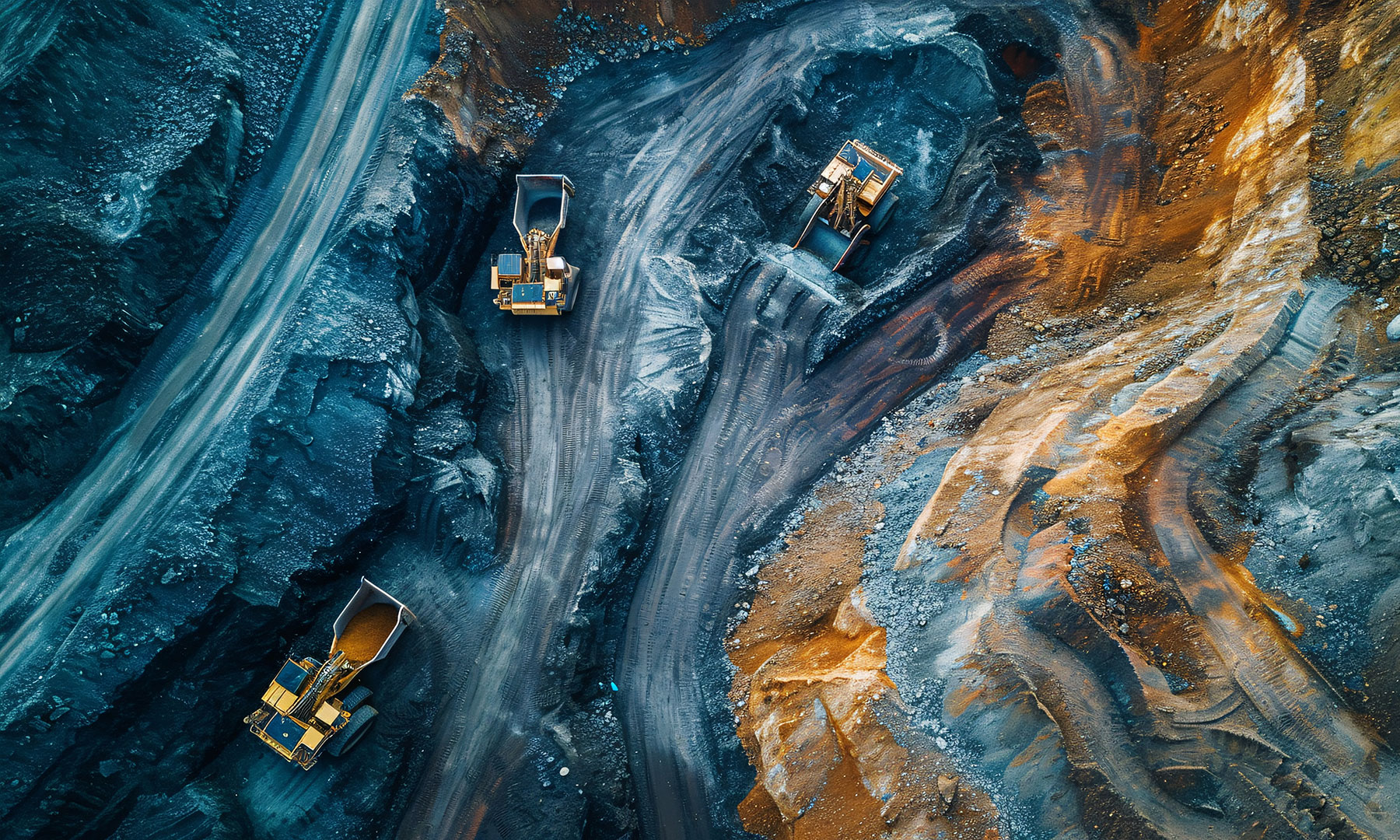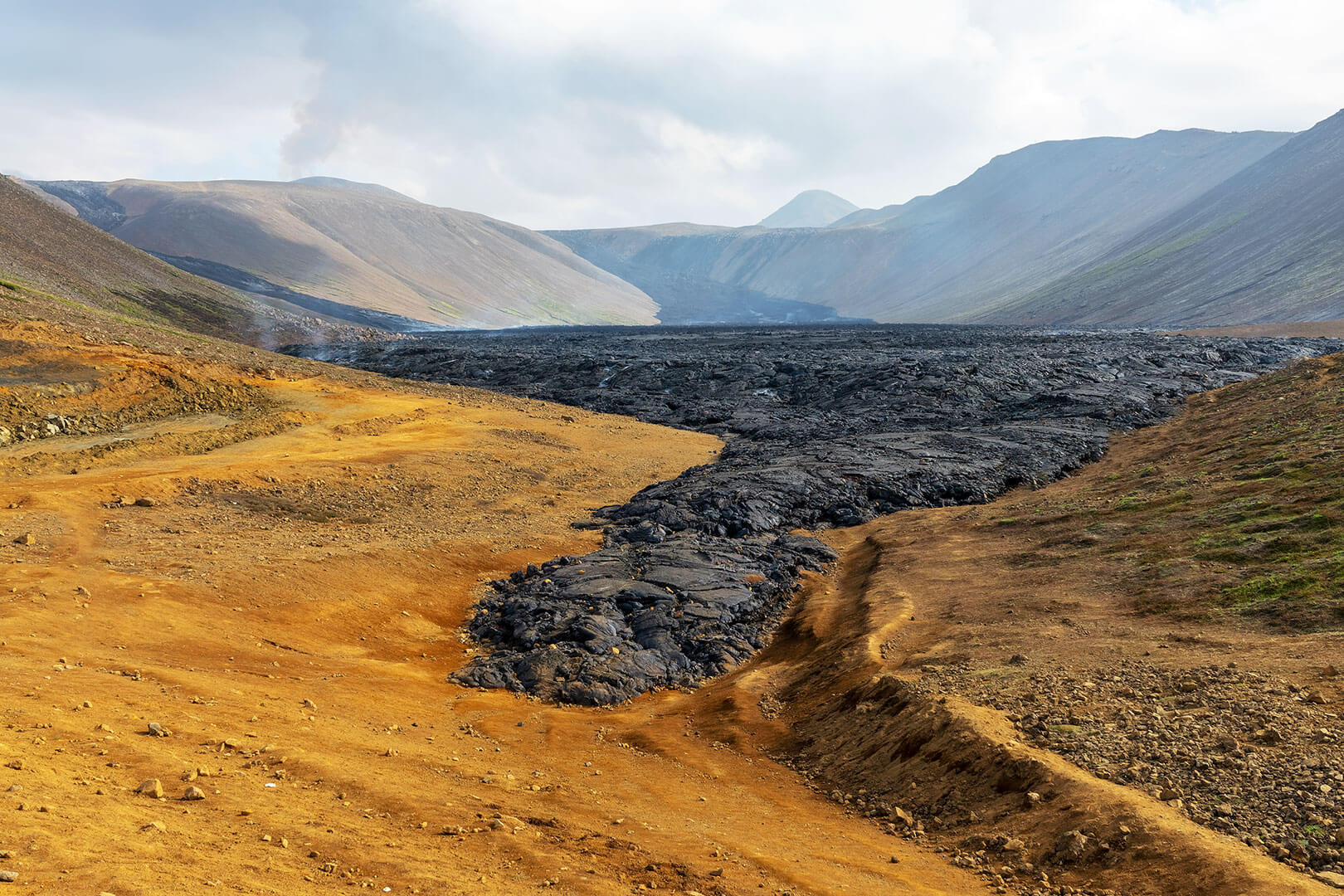History of Terminology
Rare Earths: A Group of 17 Chemical Elements
The group of so-called lanthanidesA group of 15 elements with chemically very similar properties. (cerium, praseodymium, neodymium, promethium, samarium, europium, gadolinium, terbium, dysprosium, holmium, erbium, thulium, ytterbium, lutetium and the eponymous lanthanum) as well as the two elements scandium and yttrium are referred to as “rare earths”.

“Earths” as a Historical Term for Oxides
The term “rare earths” should be viewed historically. The metals were first discovered in rare minerals such as cerite or gadolinite. The term does not describe “earths” as we understand them today; instead, it refers to an old term used in both French and German for oxides, the form in which the elements were first isolated. The oxides of rare earth elements are usually brown or black powders, but sometimes, as in the case of neodymium, they are much lighter in color.
Traditionally, the lanthanides are divided into light (atomic numbers 57-63) and heavy rare earth elements (atomic numbers 64-71). Meanwhile, scandium (atomic number 21) is assigned to the light and yttrium (atomic number 39) to the heavy representatives of the raw material group, as they have comparable chemical properties. This subdivision is not consistently adhered to in the literature. In some cases, a third group, that of the medium-heavy rare earth elements, can also be found. The representatives of the heavy rare earths are significantly rarer. Their processing is more complex than that of the light rare earths, and their market prices are correspondingly higher.
Interesting facts:
Discovery
Turbulent Journey From the Discovery of the First to the 17th Element
The discovery of rare earth elements (except for one element) took around 120 years, from yttrium in 1794 to lutetium in 1907. Forty years after the discovery of lutetium, scientists at the Oak Ridge National LaboratoryThe Oak Ridge National Laboratory is a renowned research facility in the US state of Tennessee. in the US closed the last gap in the periodic table when they identified promethium.

Rare earth elements were discovered by more than one person simultaneously. In the early discovery phase of rare earths, the technologies required to separate minerals into their elements were lacking.
The Swedish Ytterby mine near Stockholm is of central importance. Swedish officer Carl Axel Arrhenius discovered black ore in 1787, and yttrium and other rare earth elements were later discovered on the site.
A separation method developed by Jöns Jakob Berzelius and the Swedish chemist Carl Gustav Mosander played a decisive role in discovering all rare earths and significantly advanced research about them. The development of spectral analysisSpectral analysis is a procedure used to determine the chemicals that compose a metal. in 1859 also played a key role in the history of these raw materials.
Characteristics
The Chemical Properties of All Rare Earth Metals Are Similar
In elemental form, rare earth metals are iron-grey to silvery and relatively soft. They are reactive and oxidize quickly in contact with air. Some elements, such as terbium and ytterbium, are pyrophoric in a finely dispersed state, meaning they can ignite themselves.
The chemical properties of the elements, which always occur in compounds, are very similar. This makes their separation and provision for customized applications costly and complex. For some applications, such as steel production, a so-called mixed metal is therefore used. This cost-effective alloy contains 98 percent rare earth metals and small amounts of iron and magnesium.
Almost all members of the element group are paramagneticA material is paramagnetic when magnetic forces only develop when an external magnetic field is applied to it.. The heavy members are even ferromagneticFerromagnetism is a property of materials that exhibit magnetic properties for as long as they are in contact with a magnet (and shortly afterward). at low temperatures.
Areas of Application
Rare Earths Are Essential to 21st-Century Technologies
Rare earth metals are critical to industry and have numerous applications. The largest applications are permanent magnets (29 percent) and catalysts (20 percent), followed by polishes (14 percent), metallurgy/alloys (nine percent), batteries (eight percent), and glass (eight percent). Individual rare earths are used in different applications. However, as separating the elements from each other is technically complex and expensive, mixed rare earth products are used in downstream processes whenever possible.
Self-driving cars, magnetic cooling systems, and drones or civil aircraft for freight and passenger transport, which are all being developed and improved, also require rare earths. Therefore, the importance of these critical raw materials could grow in the future.
Extraction
Different Rare Earth Deposits
The minerals bastnäsite (carbonate group), monazite (phosphate group), and xenotime (also phosphate group) are particularly important for rare earth extraction. The minerals are mainly found in magmatic rocks such as carbonatite, deposited in existing rock formations through intrusion (i.e., the penetration of liquid magma). There are also placers (i.e., mineral enrichments in sediments such as sand or gravel). In addition to these “classic” mining sources, there are ion adsorption clays, in which rare earth elements accumulate on the surface of clay minerals (e.g., kaolinite).

Main Rare Earths Deposits: Carbonatite Intrusions and Ion Adsorption Clay
Carbonatite intrusions account for approximately 70 percent of global rare earth oxide production. Examples of this type of deposit are found in the Bayan Obo mine in China, Mountain Pass in the US, and Mt. Weld in Australia. Iron ore is primarily mined at Bayan Obo, with rare earths extracted as a by-product. At 69,400 tons, Bayan Obo accounted for roughly 32% of global production in 2020. Mountain Pass produced 39,200 tons, and Mt. Weld 24,000 tons in the same period. The Per Gejer rare earth deposit in Kiruna, Sweden, discovered in 2023, is also located in a mine where iron ore is primarily mined, and rare earths could be extracted as a by-product in the future. Alongside carbonatite intrusions, ion adsorption rocks are the second most important source of rare earths, accounting for 16% of global rare earth oxide production, particularly for heavy rare earths.
Extraction Process
Complex Extraction, Different Processes
The extraction process for rare earths is time-consuming and complex. Depending on the source material, it involves many physical and chemical separation processes. The aim is to selectively separate the individual elements of this raw material group one after the other to prepare them for further processing. The following sections describe how the various extraction processes are carried out.
In the conventional extraction of rare earths from carbonatites, the ore in the rock is first broken out mechanically and then crushed. The crushed ore is then wet-ground by adding water, and this ore mass is then separated from magnetic substances such as heavy metals by magnetic separation. Subsequent flotation, in which the remaining mass is placed in an aqueous solution and either floats or sinks due to the different densities of its constituent materials, produces the intermediate product, rare earth mixed concentrate. This concentrate contains a different constellation of rare earth elements depending on the starting material.
Ion adsorption clays are rare and are currently mined mainly in southern China and Myanmar. This type of deposit can be mined by direct leaching, which is easier than conventional mining. Leaching solutions, usually ammonium sulfate (and, more rarely, sulphuric acid), are pumped into a borehole, and the dissolved ore is pumped out via a second borehole. The clays also occur less frequently in combination with radioactive substances, as is the case with carbonatites, for example. This means that ion adsorption clays are a more environmentally friendly option, provided that the leaching reagents are recaptured and recycled. This practice is particularly questionable in illegal mines.
Since rare earths have different chemical properties, only one rare earth is usually required, so the individual elements must be separated from each other. To do this, the mixed rare earth concentrate is chemically split. The concentrate is first roasted and leached by adding sulphuric acid.
After precipitation using ammonium hydrogen carbonate (in which a rare earth mixture is deposited as a precipitate), the residue is leached again with hydrochloric acid, which produces the actual separation of the individual rare earths (i.e., the multi-stage solvent extraction). This extraction method, also known as liquid-liquid extraction, aims to remove a dissolved substance from a liquid mixture using a solvent. Solvent extraction has different stages, as the rare earths react differently to the solvents.
Deposits
Mining Rare Earths: Concentration in Deposits Determines Profitability
Unlike gold or silver, rare earth elements do not occur naturally in their pure form. Instead, they are part of minerals in the silicate, oxide, carbonate, or phosphate groups. Due to their low concentration, primary extraction of rare earths is difficult. However, some types of deposits have a higher concentration of rare earths.
In addition to these primary mining sites, deposits of other heavy metals such as zinc, iron, manganese, and copper contain monazite and xenotime in placers. However, as these mining sites focus on other metals, rare earths have rarely been extracted. They also often contain radioactive substances such as uranium or thorium. This production occurs in small quantities (less than 1,500 tons) in many countries worldwide — for example, in Vietnam, the US, Malaysia, Thailand, Australia, Mozambique, South Africa, and Brazil. India and Madagascar are the largest producers of heavy mineral soaps, producing around 3,000 tons of rare earth oxide annually.
Peralkaline deposits, migmatites, or magmas with an excess of alkalis over aluminum have the potential to contain rare earths, but complex processing is required here, which impairs economic efficiency. As a result, these deposits are currently virtually unexploited.
This map shows all the countries where the U.S. Geological Survey (USGS) reports figures on rare earth deposits or where this raw material group was mined in 2023. The largest deposits of rare earths are in China, Vietnam, Brazil and Russia:
China
%
Vietnam
%
Brazil
%
Russia
%
Criticality
Demand Could Increase 26-Fold by 2050
The German Mineral Resources Agency (DERA) expects the demand for rare earth metals to grow by an average of six percent annually until 2030, from 131,000 tons of rare earth oxide in 2020 to 188,300 tons. Demand will be driven primarily by permanent magnets used in wind turbines and electromobility. A study conducted at the Belgian research university KU Leuven concludes that seven to 26 times more rare earth metals would be needed in Europe alone to achieve climate targets by 2050. The International Energy Agency (IEA) is somewhat more cautious, predicting that demand in 2040 could be three to seven times higher than it is today. Unsurprisingly, the element group is therefore classified as a critical raw material by the US, the European Union, and the United Kingdom.
Political Dimension
China Has a Market Stranglehold on Rare Earths
The German Mineral Resources Agency (DERA) expects the demand for rare earth metals to grow by an average of six percent annually until 2030, from 131,000 tons of rare earth oxide in 2020 to 188,300 tons. Demand will be driven primarily by permanent magnets used in wind turbines and electromobility. A study conducted at the Belgian research university KU Leuven concludes that seven to 26 times more rare earth metals would be needed in Europe alone to achieve climate targets by 2050. The International Energy Agency (IEA) is somewhat more cautious, predicting that demand in 2040 could be three to seven times higher than it is today. Unsurprisingly, the element group is therefore classified as a critical raw material by the US, the European Union, and the United Kingdom.

Europe and the US: Dependence on China to Fall
In the last two decades, efforts to establish their domestic value chains have gained new impetus, for example, in the US. The former most important rare earth mine in the world, Mountain Pass in California, closed in 2002 due to its inefficiency in the face of overpowering Chinese competition and resumed operations in 2017. However, the US cannot process the raw materials mined in Mountain Pass into finished products. Instead, preliminary products such as oxides are shipped to China and later re-imported as permanent magnets, for example.
China also secures its access to critical minerals abroad by investing in companies specializing in these raw materials. As a result, China has for years not only been the largest producer of rare earths but also the largest importer. Around 50 percent of the heavy rare earths processed in China come from neighboring Myanmar. Despite the efforts of Europe, the US, and other countries, China’s market power is cemented for the foreseeable future.
Scandium
Scandium is important for fuel cell technology, and the supply risk of this rare earth is high.
Yttrium
Along with scandium, yttrium is one of the two rare earth elements that do not belong to the lanthanides.
Cerium
Cerium is the most common element of the rare earths. It has a wide range of applications.
Praseodymium
Praseodymium shares many chemical and physical properties as well as areas of application with neodymium.
Neodymium
The rare earth element neodymium is an important building block for strong permanent magnets.
Promethium
The natural occurrence of promethium is estimated to be less than one kilogram.
Samarium
Samarium is one of the light rare earths and is used in high-performance magnets, among other things.
Europium
Europium is one of the light rare earths and we encounter it in everyday life in fluorescent lamps and banknotes.
Gadolinium
Gadolinium has many areas of application. These range from nuclear power to medicine.
Terbium
Terbium is one of the most expensive rare earth elements and increases the performance of permanent magnets.
Dysprosium
Dysprosium plays an important role as a magnetic material and in the expansion of renewable energies.
Holmium
Holmium has the highest magnetic moment of all rare earths and is used in medical technology.
Erbium
Erbium is used, for example, as a dye and a power amplifier in fiber optic cables.
Thulium
Thulium belongs to the lanthanides and is one of the rarest elements in this group.
Ytterbium
Ytterbium is used in phosphors, catalysts, and ceramic capacitors, among other things.
Lutetium
Lutetium is the most expensive element of the rare earths. The areas of application are highly specialized.
Raw Materials Trading Industrial Customers
TRADIUM trades in all industrially relevant rare earth oxides. Choose from a wide range of specifications and take advantage of the option to reserve batches for the long term.
Purchase of Physical Assets for Private Customers
Benefit as a private customer from the exciting market for rare earths as a physical asset. You can find out here what opportunities TRADIUM offers and what tax advantages a purchase of raw materials entails.



